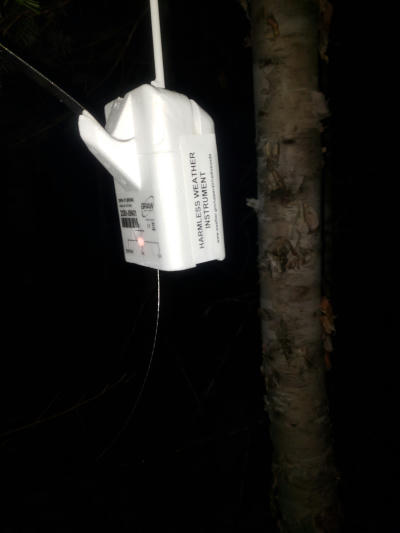About a week ago, I wrote about my failed attempt to find a radiosonde. I'm happy to report that my second attempt was a success!
Initial Tracking
Last Friday night, I was tracking a radiosonde with a very promising flight path. I was playing an online game with a friend at the time, and had Sondehub open on another screen. The predicted path tends to jump around a bit until the actual landing, so I didn't want to actually leave until I knew it was in a viable location to retrieve. The land here is very forested, so beyond about a kilometer from the road, retrieving the radiosonde becomes much harder. The other complication is that due to the curvature of the Earth and other obstacles, I can't receive its final position. Instead, I might hear it last at 1500m of altitude, and trust that the prediction is accurate (it usually is when it's that close to the ground).
In this case, when I lost the radiosonde's signal, the prediction said it would land about 500m from the road, an hour from me. Satisfied with this, I began loading up the car. Like last time, I attached an antenna to the roof of my car using magnets. I also attached a GPS antenna, which I connected to a GPS module inside the vehicle. Both were connected to a small computer running off of a 12V battery. I loaded up an arrow antenna and FT-65 handheld transceiver. Finally, I reconfigured my car to disable the CATS transceiver, and instead passed 70cm through to my mobile transceiver. I set the mobile transceiver to the radiosonde's frequency - it wouldn't be able to decode it, but at least I'd be able to hear it.
I probably should have read my previous post, because I did not bring the following:
Boots
Extra socks
Laptop
Luckily, this didn't end up being an issue. Once I had everything loaded up, I set off on the hour-long drive.
Finding the radiosonde
Once I got within a few kilometers of the predicted landing site, I started hearing the squelch open momentarily on my mobile radio. This meant the signal was weak, but present - I was definitely getting close. As I continued driving, the signal kept getting stronger. I could see my S-meter rising, and the squelch would break more consistently with each packet. Once I was happy with the strength, I pulled over to check on Chasemapper. Paranoid from the last attempt, I was sure to check that I was still connected to the correct WiFi network. I didn't have any issues, and I was able to decode the radiosonde's self-reported position. I grabbed my antenna, handheld, and old Android phone, and headed into the forest.
It was very dark and quite cold, so I was relying on my phone flashlight to see. The trek was overall uneventful. Occasionally I would pause to swing my antenna around and make sure I was still headed in the right direction. One annoying thing was that my FT-65's screen would turn off after a few seconds of inactivity, making it impossible to read its S-meter in the dark. There's a setting to change this, but I didn't want to mess with it in the forest.
Once I got within about 50 feet of the radiosonde, I saw a tiny red light in the distance. This was the radiosonde! I was relieved by this - my previous attempt had failed right at the end, when actually trying to find the device. Walking up to it, it was about 10 feet up in a tree. I was able to knock it down using my antenna as a long stick. I was very glad to bring it at that point, even if I didn't need it to locate the radiosonde.
My new toy!Getting back to my car was difficult, though not as difficult as last time. I did a lot better at not getting turned around, even in the dark. I did end up walking parallel to the road for a bit by mistake. There was a lot less snow this time, so I didn't get any in my shoes (and thus, my socks remained dry). The drive home was uneventful, and afterwards I was too exhausted to do anything with the radiosonde. It was nearly midnight at that point.
Modifying the radiosonde
After a night of rest, I was ready to being hacking on the radiosonde. To be clear, the radiosonde is disposable and they don't want it back - there's a sticker on the device confirming this. I soldered a few wires onto its programming pads and hooked it up to a programmer.
I was able to get RS41ng loaded on fairly easily. I've started adding CATS to the project, and will continue using the radiosonde I collected for that.
Learnings
Overall things went really well. The only thing I wish I had was a backpack. Trekking through the forest, carrying a large antenna, handheld, and phone, was a bit difficult. On the way back, I also had the radiosonde to contend with. I think a backpack would have made things a bit easier.
I'm really happy with how things turned out. Hopefully I'll be doing more radiosonde hunts in the future!


